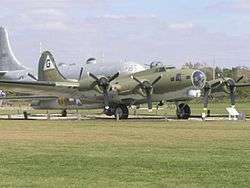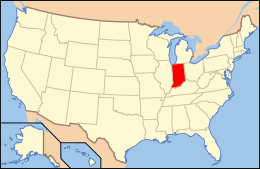B-17G "Flying Fortress" No. 44-83690
B-17G-95-DL "Flying Fortress" No. 44-83690 is a historic B-17 Flying Fortress Heavy bomber located at the Museum of Aviation, Robins Airforce Base in Georgia undergoing restoration. It was built by the Douglas Aircraft Company and delivered for use on May 9, 1945. It was flown to Grissom Air Force Base for display as a museum piece in 1961, and subsequently restored.[2]:5
B-17G-95-DL "Flying Fortress" No. 44-83690 | |
 B-17G "Flying Fortress" No. 44-83690, October 2010 | |
  | |
| Location | Heritage Museum Foundation, off US 31, Grissom Air Force Base, Pipe Creek Township, Miami County, Indiana |
|---|---|
| Coordinates | 40°40′6″N 86°7′46″W |
| Area | 0.1 acres (0.040 ha) |
| Built | 1945 |
| Built by | Douglas Aircraft Co. |
| Architectural style | Heavy Bomber |
| NRHP reference No. | 93000540[1] |
| Added to NRHP | June 29, 1993 |
It was listed on the National Register of Historic Places in 1993.[1] It was moved to the Museum of Aviation in Warner Robins, Georgia in August 2015.[3][4]
History
44-83690 is a G-series B-17, Flying Fortress, delivered on May 9, 1945 to Patterson AFB (Ohio), 4100 Base Unit, and put into storage. On November 14, 1945, it was assigned to Air Material Command, 4168 Base Unit in South Plains Field, Texas. In June 1947, it was again transferred to Air Material Command, 4141 Base Unit, Pyote Field, Texas.[5]
In July 1950, it was fitted with special equipment and redesignated as a DB-17G (Director B-17G). The conversion was completed at Olmstead Air Force Base, Pennsylvania. Once converted, it was transferred to the 3200 Drone Squadron at Eglin Air Force Base in Florida. In February 1951, 44-83690 sent to Kwajalein, Enewetak (Marshall Islands) and assigned to the 3200 Proof Test Wing as participation in Operation Greenhouse, a series of nuclear tests for the Atomic Energy Commission.[5]
In May 1951, it was once more transferred, to Patrick Air Force Base in Florida, where it was assigned to the 3205 Drone Group, 3215 Drone Squadron. Enhanced in 1955, the craft was redesignated DB-17 to serve in the 3235th Drone Squadron, Missile Test Center, Patrick AFB from 1956 to 1959. As one of the last active B-17s, it was removed from the Air Force inventory in August 1960 and in 1961, flown to Grissom Air Force Base (then known as Bunker Hill) for permanent display.[5]
The Heritage Museum Foundation, established in 1981 as part of the Air Force Museum Program, maintains 44-83690.[5] In 2015 the aircraft was moved to the Museum of Aviation at Robins AFB, Georgia and is currently undergoing a lengthy restoration.[6]
Significance
B-17G "Flying Fortress" No. 44-83690 is a reasonably intact example of a World War II aircraft type of which only 50 exist in the world. It is also an example of an experimental craft, which participated, in military tests shortly after World War II.[5]
Description
B-17G-90-DL-44-83690 "Flying Fortress" is a heavy bomber manufactured by the Douglas Aircraft Company in Long Beach, California. Douglas was one of two companies in addition to Boeing, designated to manufacture B-17s during World War II. General features of the B-17 include its mid-wing monoplane design, aluminum-clad exterior, four radial engines, massive wing structure, and heavy armament.[5]
- Crew of 10, including pilot, co-pilot, bombardier, radio operator, navigator, top turret gunner, two waist gunners, ball turret gunner, and tail gunner.[5]
- Power Plant of the later model G, had General Electric B-22 turbochargers. The engine nacelles, cowlings, and three-blade propellers are intact. Engines were numbered for reference starting with the outer starboard unit from 1-4.[5]
- The wingspan is 103.75 feet (31.62 m). The parabolic-arch-like shape of the wings encompass 1,420 sq. ft. and are characteristic of B-17s.[5]
- B-17Gs are typically 74.33 feet (22.66 m) in length with a raised cockpit section and Plexiglas nose cone. There are numerous small square windows along the port and starboard sides of the nose area and a navigator's blister located dorsal (top) between the cockpit and nose cone. The cockpit has two forward angled windows, two side windows, and two dorsal windows Waist gunner windows are staggered, the port side being just aft of its starboard counterpart to give the gunners more room to maneuver during combat.. A hatch is located aft of the starboard waist gunner's port.[5]
- The Tail fin, beginning with the E series, is massive. It is 19.17 feet (5.84 m) tall. The stabilizers are of standard T assembly.[5] The tail gunner is located below the fin. All B-17s have a retractable tail-wheel landing gear.
- The B-17G weights 32,720 pounds (14,840 kg) empty. Fully armed and loaded, a B-17 can weigh 65,600 pounds (29,800 kg) Payloads ran between 4,000–5,000 pounds (1,800–2,300 kg), but they could carry up to 17,600 pounds (8,000 kg) for sorter missions.[5]
Bibliography
- Birdsall, Steven. Famous Aircraft: The B-17 Flying Fortress. New York: ARCO Publishing Co., Inc., 1965. Note: includes partial reprint of a B-17 flight manual.
- Bowers, Peter. Boeing Aircraft Since 1916. London: Putnam, 1966
- Craven, Wesley Frank and James Lea Gate, Editors. The Army Air Forces in WWII. Chicago: University of Chicago Press, 1948
- 58 Vols. I-III (written by the U.S.A.F. Historical Division) Green, William. Famous Bombers of the Second World War. Garden City, NY: Hanover House, 1960. Vols. I & II.
Greenfield, Kent. American Strategy in World War II: A Reconsideration. Baltimore: Johns Hopkins Press, 1963.
- Swansborough, Gordon. United States Military Aircraft Since 1909 New York and London: Putnam, 1963.
- Thompson, Scott. Final Cut, The Postwar B-17 Flying Fortress: The Survivors. Missoula, Montana: Pictorial Histories Publishing Company, 1990.
- The U.S. Strategic Bombing Survey, Overall Report. Washington, D.C., 1945.
- Webster, Sir Charles Kingsley. The Strategic Air Offensive Against Germany, 1935-1945. London: Her Majesty's Stationery Office, 1961.
References
- "National Register Information System". National Register of Historic Places. National Park Service. July 9, 2010.
- "Indiana State Historic Architectural and Archaeological Research Database (SHAARD)" (Searchable database). Department of Natural Resources, Division of Historic Preservation and Archaeology. Retrieved 2016-05-01. Note: This includes Paul C. Diebold (May 1992). "National Register of Historic Places Inventory Nomination Form: B-17G "Flying Fortress" No. 44-83690" (PDF). Retrieved 2016-05-01..
- "Airframe Dossier - Boeing DB-17P Fortress, s/n 44-83690 USAAF, c/n 32331". Aerial Visuals. AerialVisuals.ca. Retrieved 19 March 2017.
- Reynolds, Jacob (12 October 2016). "B-17 restoration project to take years and thousands of dollars". 13WMAZ. WMAZ-TV. Retrieved 19 March 2017.
- B-17G "Flying Fortress" No. 44-83690; National Register of Historic Places Registration Form; Paul C. Diebold, Div. of Historic Preservation and Archaeology; United States Department of the Interior, National Park Service; Washington, D.C.; June 29, 1993
- B-17G “Flying Fortress” Undergoing Restoration; Boeing; https://www.museumofaviation.org/portfolio/b-17g-flying-fortress/; Retrieved, September 30, 2018
External links
| Wikimedia Commons has media related to Miss Liberty Belle, 44-83690. |

